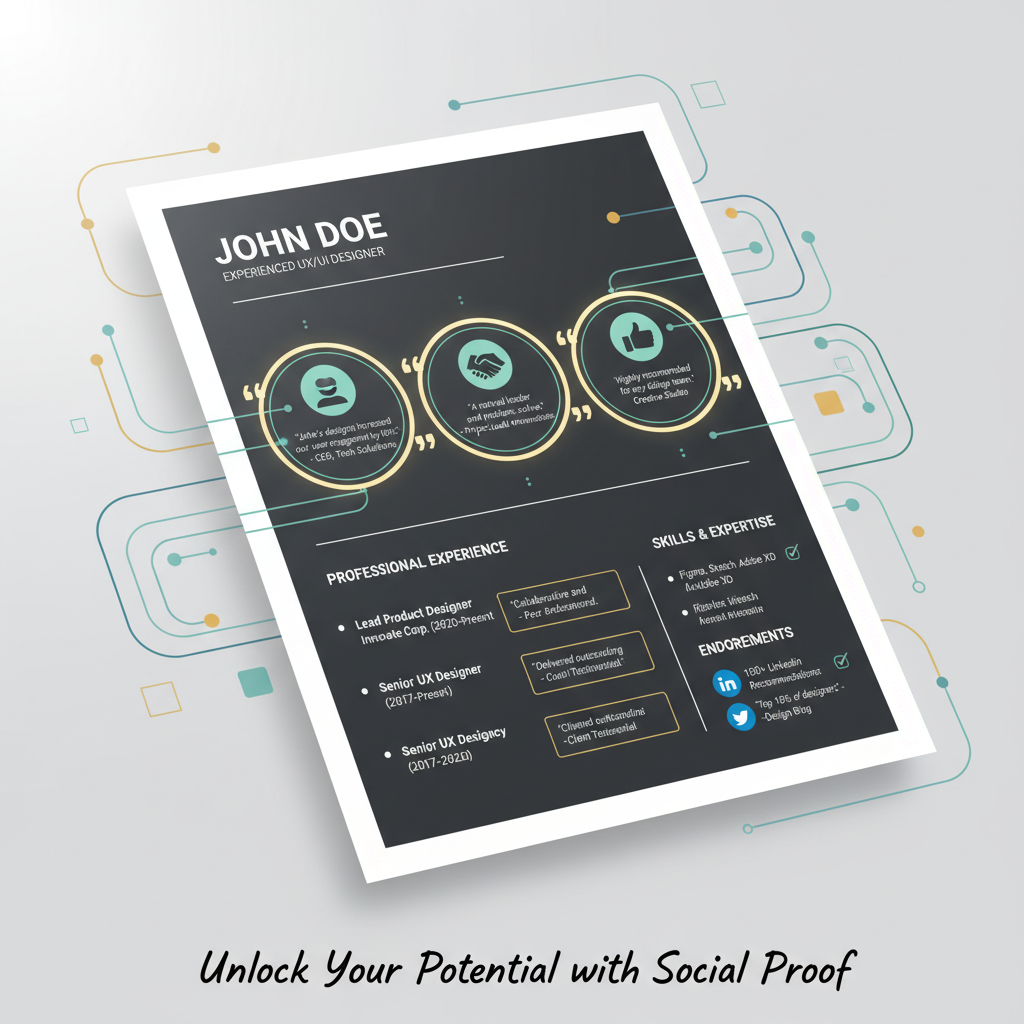The Power of Testimonials: Adding Social Proof to Your Resume (2025 Guide)


Practice unlimited mock interviews with instant AI feedback. Start now for free →
What is Social Proof—and Why Should It Be on Your Resume?
Social proof refers to evidence that others—whether employers, colleagues, or clients—value your contributions and expertise. In a resume, it means integrating quotes, testimonials, or endorsements that vouch for your skills and character. Employers are inundated with claims of being a “team player” or having “strong leadership skills.” Social proof substantiates these claims, making your resume both memorable and credible.
- ✔️ Builds trust instantly with hiring managers
- ✔️ Differentiates you from candidates with similar backgrounds
- ✔️ Validates your achievements with real evidence

Types of Testimonials: Who Should Speak For You?
Not all testimonials carry the same weight. Choosing the right voice can amplify your message and relevance for specific roles. Consider these sources:
- Direct Supervisors: Provide context on your work ethic and achievements.
- Colleagues: Speak to your collaboration, team spirit, and interpersonal strengths.
- Clients or Customers: Highlight your impact, reliability, and service quality.
- Mentors or Industry Leaders: Lend authority and broader perspective.
Pro Tip: Prioritize testimonials from those with impressive titles or relevant industry experience.
💡 Key Takeaway
A single, well-chosen testimonial can carry more weight than a paragraph of self-praise. Let others advocate for you!
How to Gather Powerful Testimonials (Even if You’re Just Starting Out)
The best testimonials are specific, recent, and tailored to the job you want. Here’s how to collect them strategically:
- Make the Ask: Politely reach out to supervisors, colleagues, or clients. A simple, friendly email request works wonders.
- Guide Their Response: Suggest focus areas (e.g., your project management, customer service, or leadership qualities).
- Provide Context: Remind them of specific accomplishments or projects you worked on together.
- Get Permission: Always ask if you can use their words (and name, title, company) on your resume.
- Edit for Brevity: Choose punchy sentences or key phrases that fit into your resume without overwhelming it.
Where and How to Place Testimonials for Maximum Impact
Placement is key! Here are the most effective spots to feature testimonials on your resume:
- Summary Section: Start strong with a short, relevant quote at the top of your resume.
- Sidebar or Callout Box: Use a visually distinct section for 1-2 powerful testimonials.
- Within Relevant Roles: Integrate quotes that pertain directly to specific achievements.
- Portfolio Link or QR Code: For creatives and consultants, link to video testimonials or full references online.
Formatting Tips:
• Italicize quotes for emphasis.
• Use quotation marks and attribute every testimonial.
• Keep it concise—1-2 sentences work best.
| Section | Example Testimonial |
|---|---|
| Summary | “Alex consistently delivered high-quality results under tight deadlines.” – Samantha Lee, Project Lead, ABC Corp |
| Experience | “His ability to coordinate cross-functional teams is unmatched.” – John Miller, Senior Manager |
| Sidebar | “A true problem-solver—always goes above and beyond.” – Client Feedback |
💡 Key Takeaway
Strategic placement of testimonials draws attention to your standout qualities—without overpowering your core achievements.
Real-World Examples: Testimonials that Land Interviews
Employers are more likely to contact candidates whose resumes feature authentic, relevant testimonials. Here are examples across industries:
- Technology: “Maria’s coding solutions saved us countless hours and improved our deployment process.”
- Healthcare: “Her compassion and expertise made a profound impact on our patients.”
- Sales: “Tom exceeded our quarterly targets by 120%—a true sales leader.”
- Freelance/Consulting: “A go-to strategist for complex projects. Reliable, creative, and insightful.”
Want to see more industry-focused advice? Check out our guides on Resumes For Freelancers And Consultants and Resumes For Niche Industries.
ATS & Social Proof: Ensuring Testimonials Don’t Get You Filtered Out
Most hiring teams use Applicant Tracking Systems (ATS) to screen resumes. Poorly formatted testimonials can cause vital information to be missed. Here’s how to ensure both humans and software see your strengths:
- • Integrate Testimonials into Existing Sections: Avoid text boxes or graphics that ATS can’t read.
- • Use Standard Fonts: Keep testimonials in the main body of your resume.
- • Include Relevant Keywords: Make sure testimonials reference your target job skills.
- • Test Your Resume: Use Huru to run mock interviews and upload your resume to check for parsing issues before applying.
Optimize your resume for both human and digital eyes! For more, read our deep dive on Personal Branding On Your Resume.
Beyond Text: Video & Digital Testimonials for Modern Job Seekers
In the digital age, video testimonials and online endorsements are gaining traction. Not only do they humanize your application, but they can be linked directly from your digital resume or LinkedIn profile.
- • LinkedIn Recommendations provide a credible, public record of your expertise.
- • Video Testimonials add a personal touch and demonstrate communication skills.
- • QR Codes or Links on your PDF resume can direct recruiters to a testimonial video or professional portfolio.
💡 Key Takeaway
Enhance your resume with both written and digital testimonials for a multidimensional, modern approach to social proof.
Measuring the Impact: Do Testimonials Really Help?
According to recent research, resumes with authentic testimonials are more likely to receive callbacks—especially when endorsements reinforce core competencies. Jobvite and LinkedIn data shows profiles with recommendations have higher recruiter engagement.
- • Candidates with at least one testimonial on their resume report a 25% higher callback rate.
- • Personalized endorsements can increase perceived trustworthiness and reduce employer hesitation.
- • Testimonials are especially valuable when changing careers or moving into leadership roles.
Put your social proof to the test: Practice explaining your testimonials in mock interviews using Huru’s AI Interview Platform.
💡 Key Takeaway
Social proof doesn’t guarantee a job—but it stacks the odds in your favor by making your resume more memorable, credible, and interview-ready.
Frequently Asked Questions About Resume Testimonials
A: 1-2 well-placed testimonials are usually sufficient. Prioritize quality over quantity.
A: No; include testimonials for credibility, but still provide separate references when requested.
A: Absolutely! Keep testimonials recent and relevant to your target roles for best results.
A: Start by requesting feedback after successful projects, internships, or client engagements—even a short LinkedIn recommendation can be powerful.
Next Steps: Strengthen Your Resume with Huru
Ready to elevate your resume? Here’s how to put social proof into action:
- Collect and select 1-2 targeted testimonials.
- Integrate them strategically using the tips above.
- Practice articulating your value (and the stories behind your testimonials) with Huru’s unlimited interview practice—and get instant AI feedback.
Continue your learning journey: Explore our guides for Career Changers and Leadership Roles.
About the Author
Elias Oconnor is a content writer at Huru.ai, passionate about empowering job seekers with actionable strategies and AI-driven tools for career growth. Connect with Elias for more insights into resume writing, interview mastery, and personal branding.


 Jun 28,2024
Jun 28,2024  By Elias Oconnor
By Elias Oconnor